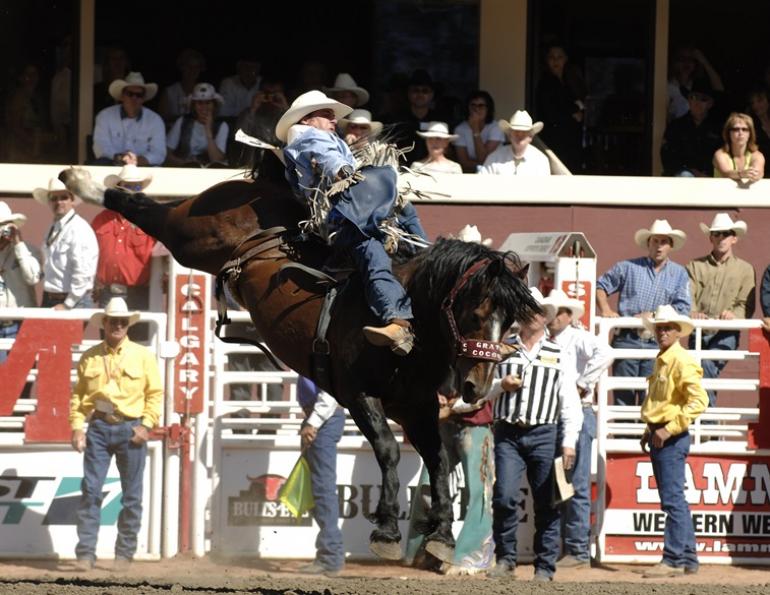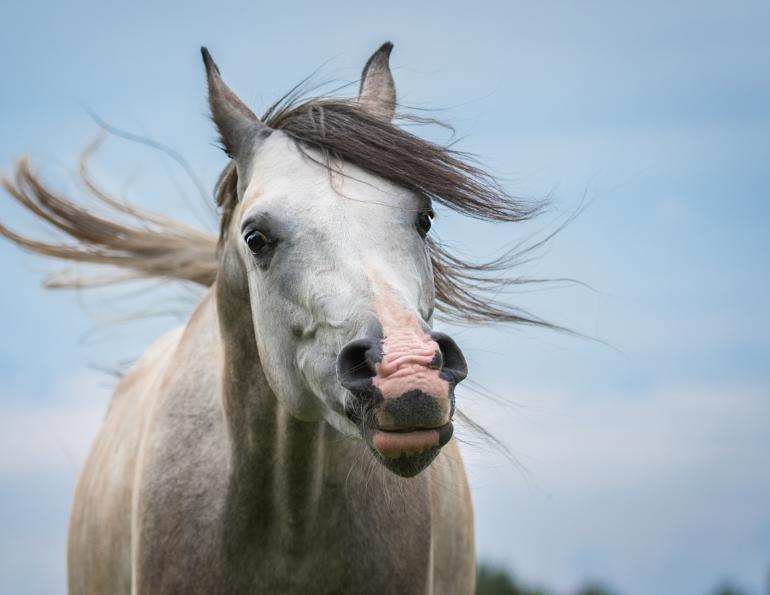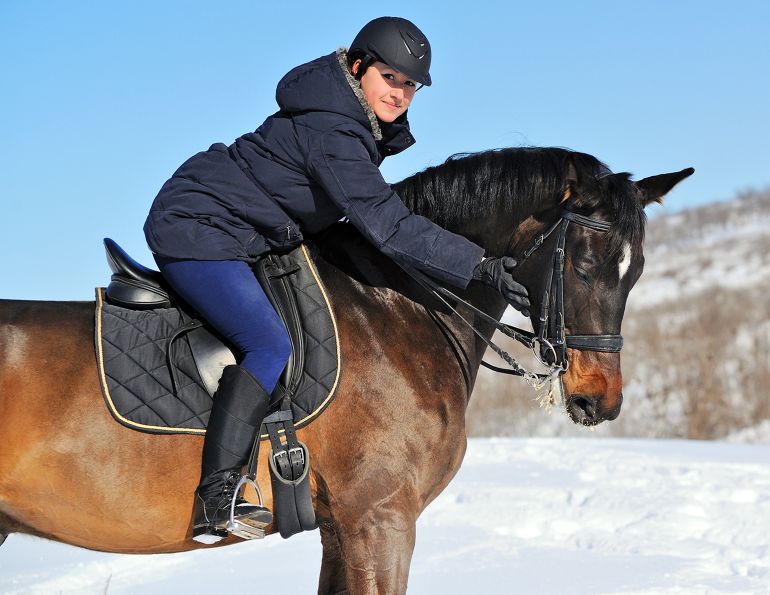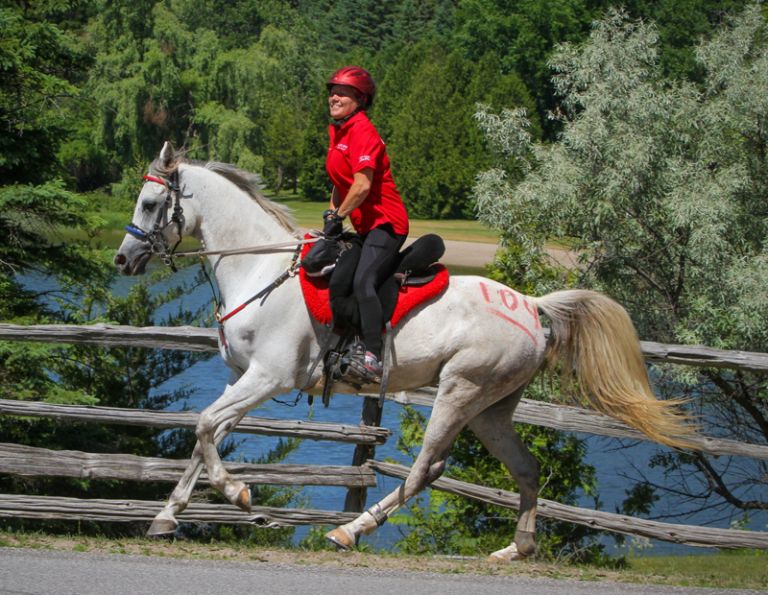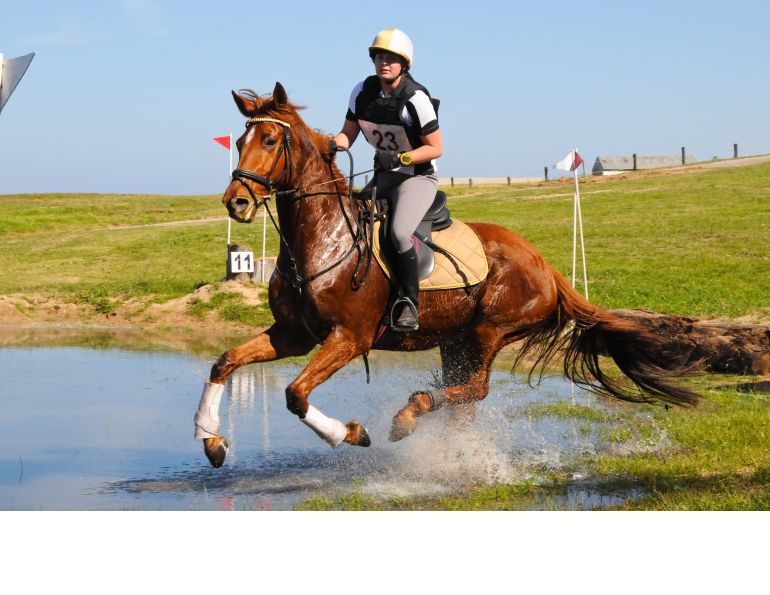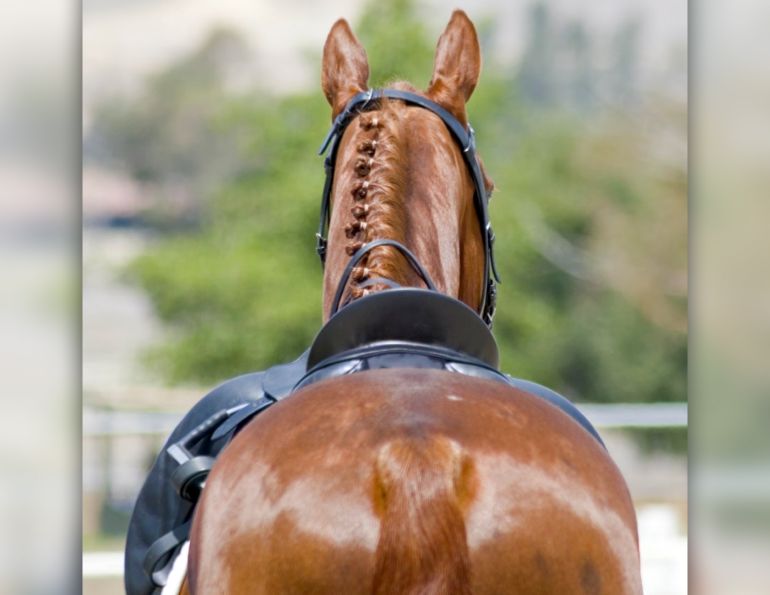By Stan Walchuk, Jr.
Walking into a tack shop and looking at a wall covered with bits can send a neophyte bit buyer into a cold sweat.
It is embarrassing to tell the sales person, who often looks as if he just won the national reining finals, that all you know about bits is that they are supposed to turn the horse left and right, and make him whoa.
Take another look and you’ll see it’s not so bad. We can simplify types of bits by putting them into two categories: snaffle bits and curb bits. The snaffle bit has no shanks or levers on the sides of the mouthpiece.
Rather, it has round rings, “D” shaped rings, or some other simple rings.

Snaffle bits have a single ring on each side, which applies direct pressure to the sides of the mouth. Shown is an eggbutt single-jointed snaffle.
A curb bit has a shank or lever on each side. A shanked bit is considered a curb bit regardless of whether it has a solid or jointed mouthpiece.The reins are attached to the rings. Snaffles work on direct pressure to the sides of the mouth (directly pulling the head around). Snaffle bits often have a jointed mouthpiece.
The reins are attached to the ends of the levers and when pulled the levers swing back and pressure is applied to the tongue and bars of the mouth, while a chin strap or chain applies pressure underneath the jaw.
The longer the shanks the more pressure is applied. With shanks of moderate length, when five pounds of pressure is applied to the reins, about fifteen pounds of pressure is applied to the mouth.
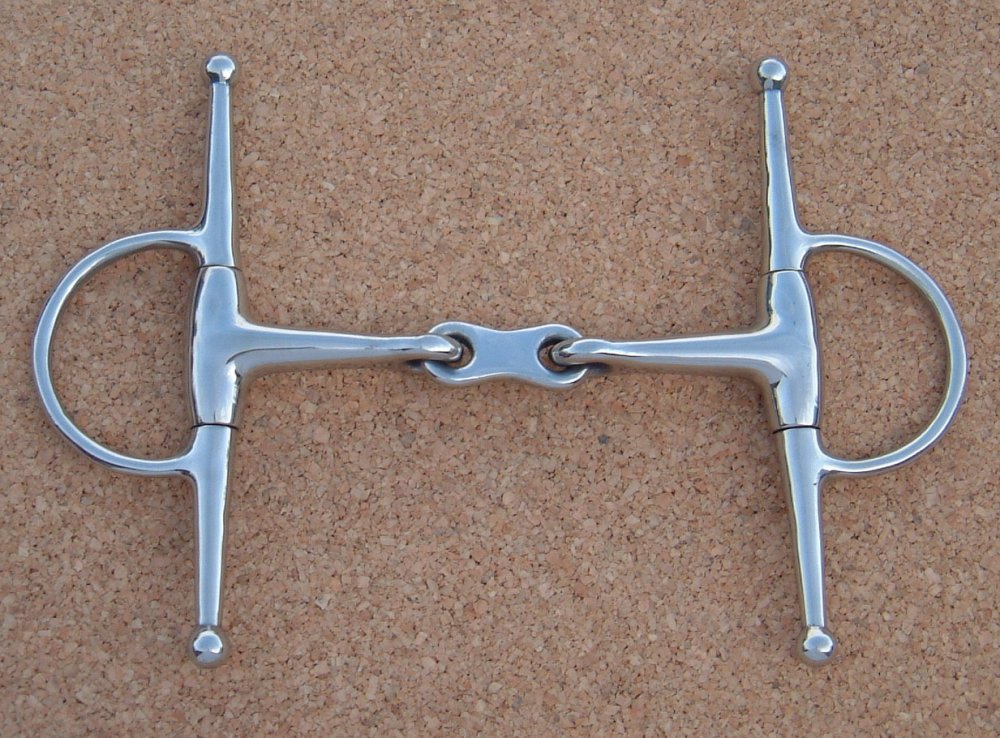
Double jointed mouthpieces are generally gentler than a single-jointed mouthpiece as, when both sides of the bit are pulled, a single-jointed mouthpiece will “nutcracker,” pinching the mouth and driving up into the palate. Shown is a full cheek snaffle bit with a French link or “dog bone” mouthpiece.
If there is a raised “port” in the mouthpiece, it will give some tongue relief and apply pressure to the roof of the mouth if it is high enough.The amount of curve in the shanks also plays a role: the straighter the shanks, the more pressure is applied.
The purpose of having the port drive up and touch the roof of the mouth is to cue the trained horse for the desired response.
A standard thickness for the mouthpiece is three-eights of an inch.
Thinner mouthpieces, for example a one-quarter inch twisted wire bit, are simply too harsh and can damage the horse’s mouth.
We have some training bits that are thicker than three-eights of an inch, but I feel that on a trained horse more thickness in not necessary and takes up more room in the horse’s mouth, reducing comfort.
The first time our horses are bitted we often use a thicker bit, sometimes a rubber bit, until they are comfortable with the feel.

Trail riders may choose to spend their entire careers using a snaffle bit, but many prefer a medium shanked, medium port curb bit like this one simply because it offers extra control and safety under difficult circumstances.
Do not progress to a curb bit until the horse is responding to indirect pressure (neck reining) and body cues. This means that the horse is calm and responds softly to cued stops, lateral flexion, riding straight between the reins, and backing up.When choosing a bit for early training, you need to use a snaffle bit as you are applying direct pressure.
Direct pressure applied on a curb bit will twist the bit in the horse’s mouth and compound confusion and pain. Using a curb bit will not help train a green horse for the above requests; proper training will.
It is extremely important that the horse’s frame of mind is soft and accepting before using any bit, meaning you need to have achieved join up, respect, and soft responses when applying pressures on the ground with a halter first.
Trail riders often ask, “Why can’t I just use a snaffle on my horse all of the time?”
You can and many riders do.
All you should really need to direct your horse is a piece of string for reins, as well as body and leg pressure.

Copper, iron, or “sweet iron” mouthpieces taste better to a horse than stainless steel and will last much longer than aluminum or plated bits. Shown is a copper loose ring snaffle bit with a double-jointed ball mouthpiece.
Does this mean that you should use a longer shank and a mouthpiece with a high port, like a spade bit for example, to increase control on a difficult horse?The reason that many trail riders and trail riding operations use a curb bit is primarily for control and safety. On the trail, situations can develop that require control in difficult and heated circumstances. Horses can become spooked, irrational, and defiant, and a curb bit simply offers more control and safety in these difficult moments.
Absolutely not. Extreme ports are for well trained horses ridden by riders who apply very subtle cues to get the desired response.
If your trail horse is defying you, it has other issues such as a lack of respect or a high maintenance personality, and needs more training time in a controlled environment like in a round pen or on a lunge line.
You need to go back to basic training for unruly and stiff horses, not a more extreme bit or a mechanical hackamore. Early training and problem solving is best done with a snaffle because it applies less pressure, not more, and you need your horse to want to respond softly to simple, light pressure, rather than to pain from an aggressive bit. Choosing the right bit is important, but proper training and using the bit properly is essential.
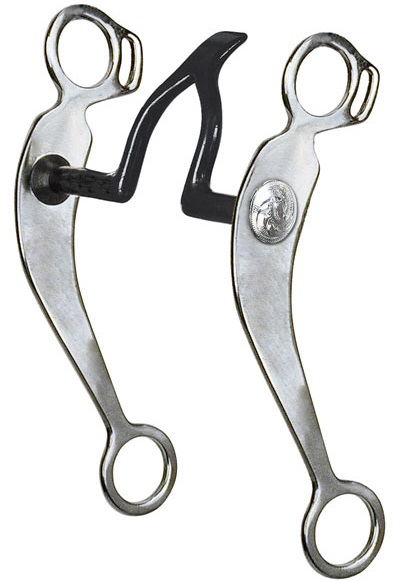
Spade bits like this one should only be used on horses with advanced training by riders using very subtle cues.
Bits vary in materials and quality. Avoid aluminum and cheap plated mouthpieces as they do not encourage salivation or taste good to the horse. Iron or copper or a combination of both is considered most desirable. You often hear the words “sweet iron” used as the most desirable material for bits.It is very important that trail riders cue their horses with bumps or pulses from early training onward as this allows the rider to communicate and correct the horse with firm bumps, then lighten up with soft pulses as the horse understands and provides the desired response. This carries on to trail situations when a horse gets pushy and wants to pass other horses or does not listen to your cues; in these situations you need to check the horse aggressively with bumps, then lighten up as the horse responds. Riders who do not communicate with body language like leg pressures, and use only bit pressures to cue horses, should take riding lessons to learn to communicate properly with their horses.
Some describe sweet iron as common black iron with carbon added as a hardener and others describe it as an iron-copper alloy. Either is very good. Copper generally has some nickel or other metal added as a hardener.
Stainless steel is a common material used in mouthpieces as it is very durable and long lasting. It is okay but does not encourage salivation and is not as pleasing to the horse.

Bits with very thin mouthpieces, such as this twisted wire curb bit, are quite harsh and can damage a horse’s mouth.
Nor do we worry about some rust on iron bits that have sat for awhile as horses have no issues with rust — some even enjoy it.Because of the number of horses we use, I settle for an iron or copper mouthpiece and do not worry about the “sweet” part.
Our experienced horses generally carry a medium shank, medium port curb bit, as do the horses at many trail riding operations.
We are mindful of the width of the bit so that it is not narrow and pinching the mouth, and not wide and sloppy.
It is adjusted in the headstall so that it just contacts the corners of the mouth, with one or no wrinkles, not two or three wrinkles, so that the horse carries or packs the bit.
The chin strap is adjusted so that when not in use you can slip the width of two fingers between the jaw and the strap.
There is really no need for a very aggressive chain on a chin strap; a non-aggressive chain or leather is just fine.
A chin strap on a snaffle bit serves no functional purpose except that on the trail. If you need to force the horse’s head around, perhaps to disengage the rear quarters of the horse that is on a runaway, the chin strap helps prevent the snaffle from sliding through the horse’s mouth.

Rollers are meant to entertain or calm a horse, not to increase or decrease the severity of the bit. Shown is a medium port curb bit with a centre roller in the port.
They vary in construction and quality, and need to be adjusted and used properly as they can encourage horses to become stiff if not used correctly.Bitless bridles and non-mechanical hackamores are wonderful for both training and trail riding but they are a separate science and need to be studied before you use them.
For a few years I used a short shanked curb bit with a jointed mouthpiece commonly called a Tom Thumb.
I believed, like many, that they were gentle in the mouth because of the jointed mouthpiece, but discovered that a single jointed mouthpiece actually pinches together and drives up into the roof of the mouth when the shanks are engaged.
A double jointed mouthpiece, with a ball or a link in the middle, is gentler.
The straight shanks of the Tom Thumb also make it quite harsh.
You often see rollers in the mouthpiece of bits. Their job is to provide entertainment or activity to occupy or calm the horse, and to encourage salivation.

While often considered a gentle bit due to its single-jointed mouthpiece (often associated with the mild snaffle bit), the Tom Thumb bit is actually quite harsh due to its very straight shanks and the nutcracker effect of the mouthpiece.
They are not intended to increase or decrease the severity of the bit. If I happen to have one I will use it, but see no real advantage, and at times a horse who constantly fusses with one may be a bit of a nuisance.
Bits and bridles are systems and systems are not perfect in all circumstances. Trail riders are not perfect either and conditions on the trail can be far from perfect.
Even though you are not supposed to plow rein or apply direct pressure on a curb bit there are times in the life of a trail rider when you will.
Maybe the horse bolts and turning it is critical to preventing a runaway, maybe the trail is eroded and drops off, or maybe the trail suddenly becomes dangerous and you have to halt even when others do not, and so you end up reefing on your bit as a matter of survival.
Suddenly the calmness, disposition, and training of your trusty trail companion shines through, or perhaps it lets you down harshly. At unexpected times I have ridden many miles with nothing but a string for reins and a rope halter for a headstall, and with no difficulty, but I shudder in my gum boots at the thought of doing so with a high strung horse. Walk a mile in my stinky old gum boots and you will understand.
Happy trails!
Read more by Stan Walchuk on this site.
Main photo: Robin Duncan Photography - With the huge number of bits available, it can be daunting to go to the tack store and choose one for your horse. With a little knowledge, however, choosing the right bit can be much easier. The bit you choose for trail riding may not be as important as how you use it, and your horse’s training and disposition.



